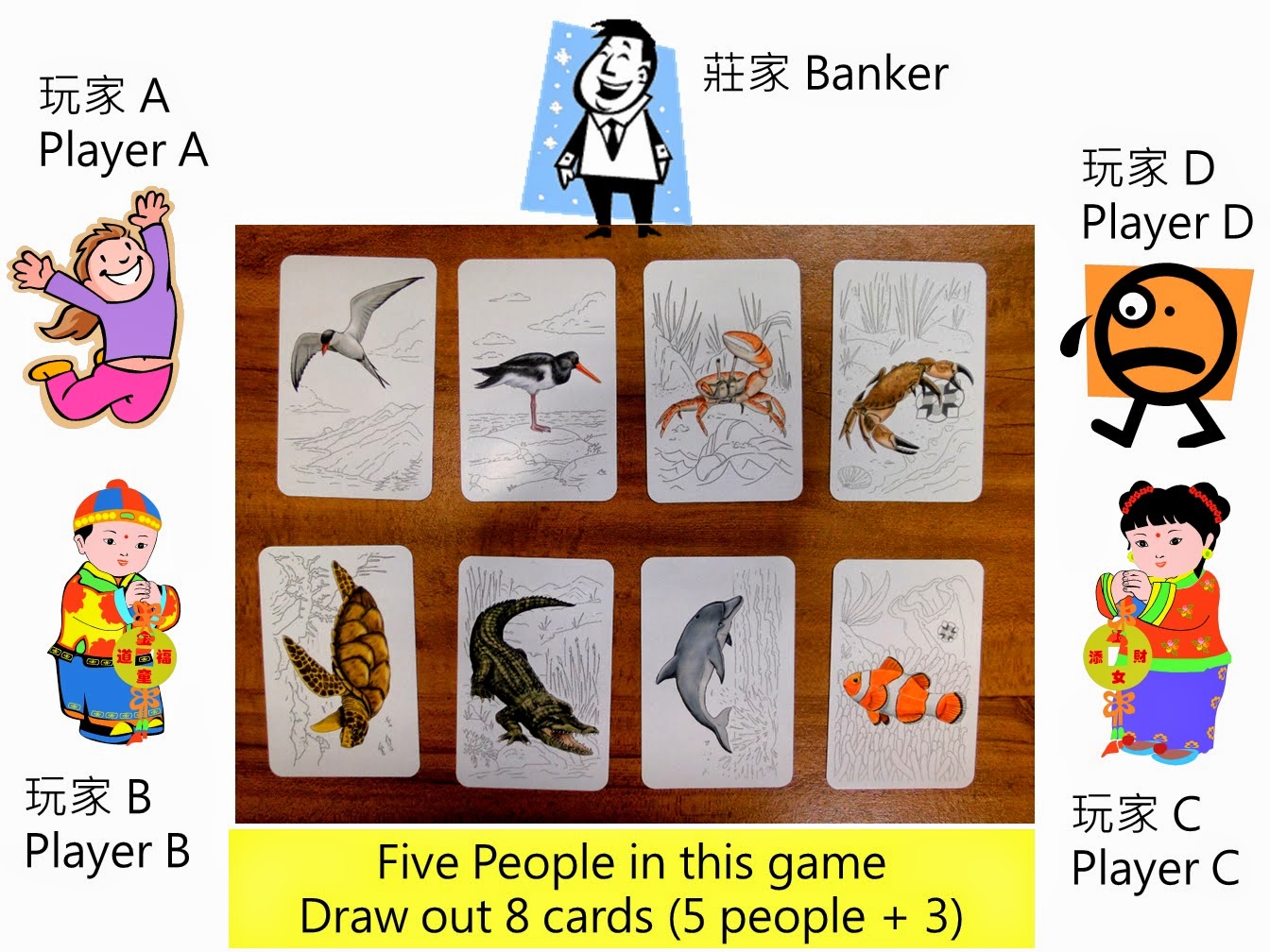那麼《Manymals》有別種更有趣的玩法嗎?可以有更多層次的戰術運用,最好再來一點難以捉摸的運氣與機率成分,此外最重要的,當然也得發揮生物學教育意義。嘿嘿,那就來試玩看看我腦力激盪所獨創出的《Manymals》新玩法,或許可以滿足各位桌遊同好與生物老師,讓《Manymals》提供更多的樂趣與教學功能。
如果大家對國中生物課還有一點印象的話,應該記得曾經幫一群奇怪的甲蟲進行分類,依照體型、觸角形態、斑點數量、腳毛有無…等特徵,做出一份分類檢索表(identification key)。實際上,這種分類檢索表不僅能應用在動物分類,在植物分類學也被廣泛地運用,可說是生物領域非常重要的一門學問。
然而對國中生而言,學會製作分類檢索表有啥好處?分類檢索表其實也可以活用於協助歸納與統整的課堂筆記,例如界門綱目科屬種的分類階層概念,假如能利用檢索表提供整體架構,想必會比只介紹個別階層的特徵來得更完整。
因此在《Manymals》的新玩法中最關鍵的一點是,你得懂得「如何問一個好的問題」,幫助你透過類似跑分類檢索表的過程,藉由每個生物的特徵異同推斷出哪一個動物才是你的致勝標的。可別小看問問題唷,生物學家在製作分類檢索表時可是得花費許多時間與心血,觀察並累積足夠的經驗與資料,才能藉由幾項扼要的分類特徵去做到精細的物種分類。
好吧,廢話不多說,以下是《Manymals》的新玩法遊戲介紹。為了將這個新玩法推廣給外國喜愛《Manymals》的玩家,我也試著翻譯出英文介紹,翻譯若有錯誤敬請見諒,並歡迎留言更正。若是對牌卡本身圖案說明有疑問,可先參閱前一篇的《Manymals》桌遊介紹。
《Board Game》Manymals - advanced version
◎Course of the game:
1.
第一回合,由最年長的玩家先做莊家,將牌堆洗牌之後,抽出比現場所有玩家數量再多三張的動物卡,並以正面朝上的方式,平均散布於桌面出示給所有玩家看見,玩家觀察時不可動手將卡片翻到背面。
1.
First
round, the oldest player (or the teacher of biology) is the banker hosting this round. After shuffling
all of the animal cards, the banker draws out the cards with “the number of people +3”, and shows
them on the table with the animal side
up. All players can observe the cards without
turning any one of the cards on its back side.
2.
等所有玩家看完桌面上的卡片後,請莊家將桌面上散布的卡片收回並洗牌。
2.
After
all players finish their observation, the banker collects the cards and
shuffles them.
3.
莊家可以觀察收回的動物卡背面的特徵說明,從中選擇一張動物卡作為本回合的目標卡,此目標卡不能讓莊家之外的其他玩家知道。選牌過程中,莊家可要求其他玩家轉身或閉眼以避免偷看的作弊行為。莊家在遊戲中也不可做出任何行為暗示自己所挑選的是哪張動物卡。
3.
The
banker can observe the back side of these cards, and then choose one of the
cards as the target card in this
round. The target card should not be
known by other players. Therefore, when choosing the target card, the banker is
able to ask other players to close their eyes or turn around to avoid cheat.
The banker is prohibited from hinting
which one is the target card by any way.
4.
莊家選擇完本回合的目標卡之後,須將目標卡的動物名稱寫在答案紙上,並將答案紙覆蓋於桌邊,以便於本回合結束時,證明莊家最後揭曉的目標卡答案是否作弊及變更。
4.
After
choosing the target card, the banker has to write the animal’s name of the target card on a piece of paper, and
then turns the paper over on the table. In the end of this round, it will be
used to prove whether the banker cheated and changed the target card.
5.
請莊家將本回合抽取的動物卡,再次正面朝上平均散布於桌面上,然後其他玩家即可轉身來或睜眼。
5.
The
banker spreads out the cards in the middle of the table with the animal side up
again. Meanwhile other players are able to open their eyes or turn around.
6.
從莊家隔壁的玩家開始,可依順時鐘或逆時鐘方向輪流詢問莊家一個問題,以了解莊家所選擇的目標卡具有的動物特徵。問題限定只能與本遊戲提供的各項動物特徵有關,並以能簡短回答的是非題或簡答題為主。玩家可由莊家的回答,思考並歸納本回合的目標卡可能是哪一張,以做為答題時的參考依據。
6.
Begin
with the player next to the banker, each player asks the banker a question one after another in order to know the characteristics of the target animal
card. The question must be related to the characteristics which are offered by
this game and shown on the back side of the animal card. It is far better to ask
yes-no question or short answer question. According to the
answer from the banker, the players may infer which one is the target card.
7.
回答玩家的問題時,若莊家對目標卡的動物特徵認識不足,而無法直接回答的話,則必須拿取桌面上每一張動物卡,並逐一檢視其背面的動物特徵,不可只單獨檢視目標卡而導致洩漏答案。檢視過程,不可讓其他玩家看到動物卡背面的內容,並且儘可能避免不同卡片檢視時間的差異而造成暗示。此外,請莊家務必確定自己給予其他玩家的回答是正確無誤的。
7.
The
banker has to answer the player’s question correctly. If the banker is too unsure
to answer, the banker must pick up all
of the cards on the table and check the characteristics on back side. The
banker should not observe only the
target card or offer any hints for cheat; besides, don’t let other players peep
the back side of card.
8.
當第一位發問的玩家與莊家結束問答,便可進入答題階段。答題順序以發問者為優先,然後依序為隔壁的下一位玩家。每一回合當中,每個玩家只擁有一次答題機會,因此若該輪問答無法提供充足的線索,玩家也可選擇不回答以保留答題機會。
8.
When
the first player finishes the Q&A, it’s time to guess the target card. In a
round, each player has only one opportunity
to guess the target card. The first player who asks banker a question has priority
to answer the target card, and the player next to the first player is the
second to guess orderly. However, the player can decide to pass and save the opportunity if the clue is insufficient from the Q&A.
9.
當有玩家在答題階段選擇了錯誤的動物卡作為答案,即成為本回合的輸家,不可再作答與詢問莊家問題。錯誤的動物卡可拿到桌邊放置,以免混淆未作答的玩家再次選到此卡。
9.
The
player choosing the wrong card
becomes the loser in this round. The loser is unable to do the Q&A and
answer the target card again. The wrong card can be put aside lest other players
choose this card again.
10.
若第一次發問與回答結束,並未有玩家回答出正確答案,則輪到隔壁的下一位玩家發問。第二次問答結束後的答題階段,則由此輪發問者取得回答優先權,相對的,前一輪發問者則成為最後答題者。
10.
If
all players do not answer the target card correctly after the first Q&A,
then it’s turn for the second player next to the first player to do Q&A and
have priority to answer the target card. Oppositely, the first player finishing
the Q&A becomes the final one to answer the target card.
11.
遊戲回合進行直到有玩家在答題階段率先回答出目標卡的正確答案,即為該回合的贏家。但若所有玩家在答題階段都回答出錯誤的答案,則該回合的贏家為莊家所有。
11.
There
are two conditions that the round is end: (1) one of the players answers the
target card correctly, so this player is the winner; (2) all players answer the
target card incorrectly, and consequently the banker is the winner.
12.
新的遊戲回合,改由前一位莊家的隔壁玩家擔任新的莊家,將上回合的動物卡捨棄,並從牌堆抽取新的動物卡開始新回合。遊戲的回合數可自行決定,獲得最多次贏家的玩家即為本遊戲的冠軍。
12.
New
round, the player next to the former banker is the new banker. Removing the
used animal card, the banker draws out the new animal cards and starts the
round. The number of round in this game can depends on the length of time. The
player winning the most rounds is the champion.
◎遊戲要訣:
1.
莊家對於目標動物卡的選擇
若是莊家想讓其他玩家都答錯來贏得該回合,最好挑選與多數動物卡具有共同特徵的卡片作為目標卡,以降低問答提供的辨識度。但若是在遊戲中後段的回合,莊家則可針對目前獲得最多次贏家的玩家,藉由該回合問答與答題的順序,決定目標卡的辨識度來降低特定玩家的獲勝機會。
2.
玩家在問答階段可靈活運用剖半法或單挑法
剖半法,藉由詢問半數動物卡所共有的特徵,來淘汰不符合目標卡特徵的卡片,但此法相對的亦會保留下半數卡片,而降低發問者優先回答時的答對機率。單挑法,專攻只有一張動物卡獨有的特徵,這樣只要藉由一次問答便能鎖定正確答案,但若是無法命中目標卡,則會保留許多卡片下來而降低答對機率。
3.
遊戲開始時抽到的動物卡間的異同程度,決定了這回合的戰略
當動物卡之間的相似程度越高,通常需要藉由多次問題才能大幅縮小目標卡的可能範圍,此對莊家與問答順序較晚者較有利;當動物卡間的差異程度越高,則可能兩次問答以內就可獲得答案,對優先問答與作答者較有利。
4.
問答順序與答題的優先順序是戰術致勝關鍵,但也別小看運氣
把握問答的優先權,可以大幅提升答題的正確率並先馳得點;但問答順序較晚者並非完全居於劣勢,有時大膽猜測也能幸運命中。在機率與運氣之間,勝負經常只在一念之間。
5.
觀察莊家的一舉一動,都是一種心理戰術
只有莊家知道哪張是目標卡,從問答過程中莊家的思考時間與神情,有時可以發現意料之外的線索。不過當你遇見老奸巨滑的莊家時,可就得小心莊家也可能故意誤導你掉進他的心理陷阱。
◎遊戲心得:
我當初剛設計好這個新玩法時,原以為要猜出目標卡應該不是件困難的事,但實際上沒那麼容易耶!因為玩家通常會詢問比較明顯可見的特徵,例如腳的數量就是個很有用的問題;相對的,玩家應該很少詢問連自己都不太知道的特性。
然而,《Manymals》歐洲版牌組的動物其實有不少相似度都超高的,例如光是鳥類就超過十種,哺乳類的數量也非常多,因此最後經常會淪落到不知該怎麼問的窘境,只好靠運氣決定勝負。其實遇到這種結果,就很適合引導學生思考生物分類學家在研究中常遇到的問題:當分類階層分得越細之時,是否就需要藉由觀察更多、更細微的特徵來協助物種的分類。
 |
| 相似度超高的動物卡組合 |
在玩家與莊家Q&A的過程中,也可以讓玩家分享為何他們要問這個問題,同時幫助分析與釐清每個分類特徵可能具有的功能與意義。當然,也可以反過來質疑他們所問的問題是否真的有生物學上的演化與分類意義,例如腳的數量,螃蟹和魷魚都是十隻腳,那麼他們的親緣關係是否也比較近呢?這些都可以幫助學生們深入思考與了解生物分類學的知識與應用。
每玩完一個回合,也許能順利完成一個由玩家自製的分類檢索表,老師可以帶領學生一起討論,例如有沒有更好的分類方法能更快鎖定目標。或者讓每位學生把本回合使用的動物卡擺放在畫出的檢索表上,有時候會發現學生可能因為對分類學知識的認知差異或誤解,而擺放出不同的分類結果,這也是一個很好的討論議題,可藉由群體討論引導程度較低或觀念錯誤的學生,提升並改善他們的學習結果。事實上,在生物領域的學術研究單位,許多分類學者的研究就是在探討這些議題。如何藉由淺顯易懂又有趣的方式,帶領學生從桌遊潛移默化深入到科學研究,對有興趣帶領學生參與研究的生物老師而言,挺值得嘗試看看的。
玩過《Manymals》之後,我衷心覺得應該出個植物界版本的類似桌遊啊!例如常見的校園植物就很適合拿來玩,一方面可以讓學生透過遊戲認識校園植物,另一方面又能把植物形態學、分類學、演化學的知識一氣呵成融於一爐。此外,或許也能提供不同版本的補充包,像是台灣原生植物版本、常見蔬果作物版本,甚至每座國家公園都可以自己出一套專屬的桌遊呀,可以拿來玩,又可以當圖鑑使用,還能當藝術品收藏,好遊戲好商機不推可以嗎?












